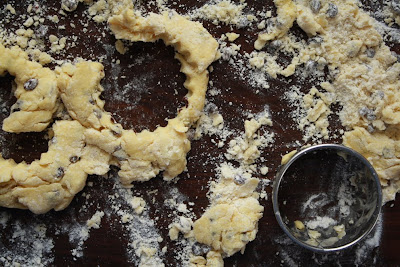If you made the cheesecake below, you might be wondering what to do with all those egg whites and all that leftover lemon curd. Maybe you already made lemon meringue tartlets. If not, you could try making macarons. I should warn you, though: if they work you'll be overcome with baking euphoria, if not... not. You decide whether it's worth the risk.
The first time I attempted to make macarons, it was a macaron massacre. I aged the egg whites like the recipe told me to and heated the syrup to so-many degrees before drizzling it down the side of the bowl while the whites were whipping and folded in the almonds and sugar just so and piped and waited and baked and then... they were lop-sided and hollow and just plain wrong. I was despondent for the rest of the day. This time I felt like I cheated somehow by making them with French meringue instead of Italian, but when I opened the oven and saw the perfectly shiny domes and frothy little collars, I didn't mind quite so much.
I hope your audience is as appreciative as mine was. I took my macarons to work with me and was positively regaled with praise. "They look like little hamburgers," S. said, "but taste like lemon meringue pie!" Another co-worker said, "I don't know what those are, but I want the recipe." Well, here it is.
Lemon Macarons
adapted from The Fundamental Techniques of Classic Pastry Arts
- 115 g almond flour
- 200 gconfectioners' sugar, sifted
- 90 g egg whites, room temp
- 8 g confectioners' sugar, sifted
- 1/2 tsp. almond extract
- lemon curd
- Line a baking sheet with parchment or a silicone mat and set aside.
- Place the almond flour and 200 g sugar in a food processor and process for about a minute. Set aside.
- Place the egg whites in the bowl of a stand mixer fitted with the whisk attachment and beat on low until whites are foamy. Add the sugar and beat on high to the soft peak stage, being careful not to over-whip.
- Remove bowl from stand and fold in the almond mixture and almond extract using a rubber spatula. Transfer batter to a pastry bag fitted with a medium round tip.
- Pipe rounds of batter onto the parchment lined baking sheet, leaving enough room between them for the batter to spread slightly. Make the rounds any size you want so long as they're all the same size. If it helps, you can even draw circles on the parchment as guides.
- Let the uncooked macarons sit for about an hour before baking. They will form a skin, which will help them keep their shape during baking. Preheat the oven to 325°F. Bake for about 10 minutes, or until firm and just beginning to brown around the edges.
- Immediately transfer macarons to wire racks to cool. Once cool, pipe a mound of lemon curd on half the macarons and sandwich them with the other half, pressing them together to squeeze the filling to the edges.






















